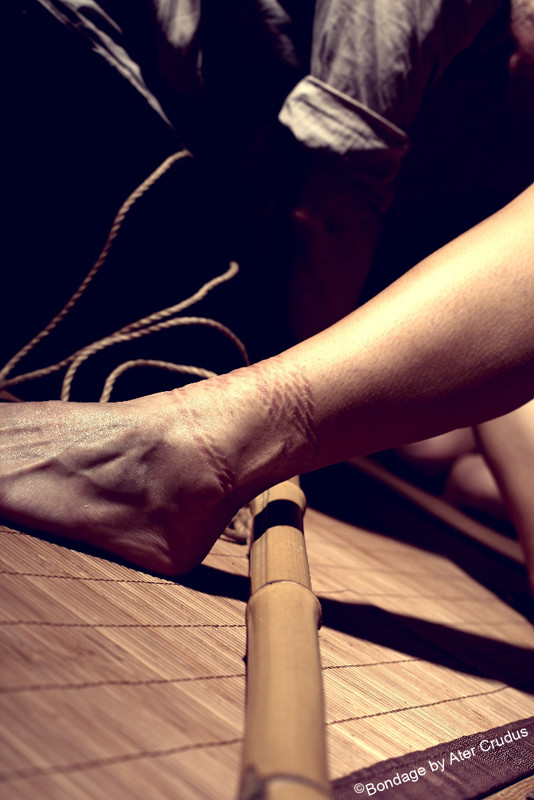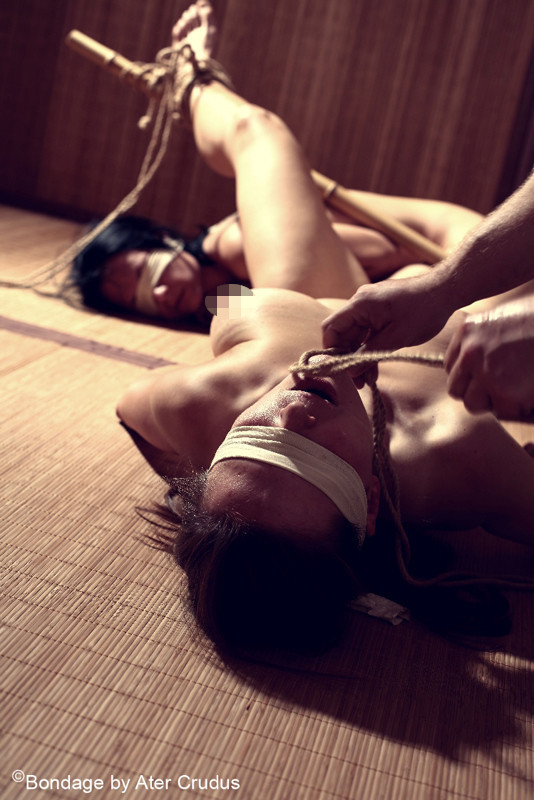With this article we begin our series on the topic: "Introduction to the world of bondage". With rope artist Ater_Crudus we want to explain to you the basics and gradually move on to more complex bondage.
Before we show you step by step how to tie a standard bondage knot, we want to discuss some theoretical aspects concerning bondage motivation, bondage safety and appropriate ropes.
What comes to mind when you hear the word bondage?
To be bound, to be helpless? To trust the binder, to surrender, even to fly? No matter if emotionally or physically because you're suspended in mid air.


The feeling of security and protection and constantly knowing that you are "in the hands" of the other person. Being subdued until you are totally unable to move. Or, being "strung up" in an attractive way to star in fabulous photos and sensual snapshots of ropes that highlight the shapes of your body.
These are the most common desires before an encounter with ropes as a passive participant. Desires that perhaps also arise or are enhanced due to countless images and videos on the internet.
Bondage in the media is rarely authentic
The internet is full of specialized sites, mostly paid, that deal with bondage in their own way. They often depict typical BDSM situations.
Most of the female protagonists appear to be "tortured" in impossible positions, perform acrobatic stretching and often their bluish hands, breasts or pain-scarred faces are the focus of these images and videos.
It should be noted that both bondage and BDSM as a tool have found a fixed place in the world of commercial media. However, these are rarely authentic accounts of bondage as it is understood by its followers.
The extremes shown in these cases often involve professional models with stunt experience or professional actors who are both physically and psychologically prepared to withstand this type of practice.
Acrobatic postures should only be performed with caution and taking into account the will and possibilities of the person tied. In order to protect against unpleasant results and experiences, we should take a critical look at the representations in the media.
For most people, the ambition behind practicing bondage is not to take images and have experiences as the ones portrayed in the media. Each bondage encounter is as individual as those involved. In practice, we should simply listen to our instinct when it comes to intensity, acrobatics and ways of performing bondage.
Often, the most intense encounters are those that arise from reason, common sense and intense, authentic feelings, rather than those that are motivated by partially erroneous representations of bondage in the media.
In bondage, technique is important, but feelings even more!
Beginners in particular are very attentive to the technical aspects. Sometimes, it also happens that only one of the parties involved wants to experience bondage and the other "plays along", which is not an ideal circumstance.
In these cases, sometimes reality hits very hard. Instead of countless incredible sensations of "letting go" and unbridled play, we often find ourselves in disillusionment. The "knotter" focuses on doing everything correctly, the passive person gets bored and possibly thinks from time to time "how long will he have to keep tying knots until the fun begins?".
Additionally, the "knotter's" ideas often clash with the skillset they have. That is, there's lots of ideas, but not the know-how to implement them without making mistakes. And then there's medical concerns that are going around in their heads. In reality, all of this can lead to the much desired pleasure being kept hidden.
In bondage, people progress (together) slowly and continuously. Not everyone has to learn and master all the intricacies and techniques. Often, it is enough to have a solid foundation from which both people can develop their confidence and courage, so that in this way, the pleasure moves more and more into focus.


In order not to be victims of a disillusioning reality, all participants should show compassion and patience with the other person. Allow time for each other, value the other person for dedicating themselves to you and for wanting to help you realize the bonds.
Be clear about your motivation for bondage
Before holding a rope in one's hand, one should ask oneself, however trivial the question may sound: Why do I want to tie or be tied? This way misunderstandings can already be avoided.
The possible motivations can be to perform an aesthetic binding for a fabulous photo shoot, to simply fixate a person, the total immobility of your partner, a mid-air suspension or even a real game with the rope as an expression of power and arbitrariness, but also of eroticism and sensuality.


Often, the passive party has thoughts like: "Can it be over already?", "What's he doing back there for so long?" or "By the time we're ready, I won't be in the mood anymore". Only if both people have the same motivation during bondage, they will also be able to enjoy the situation and the ropes equally.
Thus, for example, a certain amount of resistance can quickly turn into stimulation. And no one will get bored if you "simply" prepare a luxurious bondage with jewelry for a photo shoot (agreed in advance).
Talking about your own motivations, desires and ideas creates a relaxed atmosphere and helps to prevent unsatisfactory encounters from happening.
Health concerns and risks of bondage should not be ignored
Bondage is and always will be a risky practice, but with some solid basic knowledge and sensitive treatment of the other person, most bondage encounters are rewarding without any risk.
Choose the right rope for you
Whether cotton, jute, plastic or hemp, the choice of ropes is, after all, a matter of taste, and each person should acquire their own experiences with them. In principle, a tying rope should meet the following criteria:
- Regarding the material, the rope should be made in such a way that knots can also be undone under tension.
- Ideally, the rope shouldn't stretch too much when subjected to loads.
- The rope should "slide" well through the hand of the active person.
- The rope shouldn't heat up too much under friction.
- The rope should have an appropriate breaking load for its use. The breaking load is the value in kilograms at which a rope breaks when used. Ropes made of cotton, jute, hemp, and plastic vary greatly depending on their thickness, condition, and manufacturing. The important thing is to gather necessary information before purchasing them. As a general rule, the breaking load only plays a decisive role if full or partial suspension ties are to be performed; in these cases, for simple ties, it should be between 70 and 220 kilograms.
A small recommendation on this subject: exchange information with acquaintances and friends about the ropes they use and the experiences they have had with the selected materials, or ask in specialized workshops or rope stores!
JOYclub: What is that?


- With over 5 million members, JOYclub is a lively, sex-positive community that will turn your love life completely upside down.
- Whether you're male, female, trans, single or a couple, JOYclub is the place to discover and live out your erotic fantasies with other members (and with your partner, if you like).
- Curious? Then register for free and without obligation and discover the fascinating world of JOYclub. We are looking forward to meeting you!







